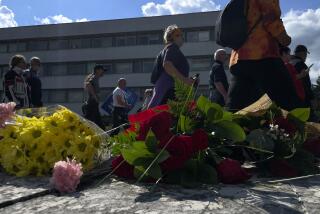Sweden’s Biggest Case Is Still Unsolved : 2 Years Later, Police Still Don’t Know Who Killed Prime Minister
- Share via
STOCKHOLM — Detective Hans Olvebro believes the identity of the gunman who killed Prime Minister Olof Palme is buried somewhere in the tons of documents or megabytes of computer data in police files.
“I am an optimist. We have him somewhere in our material,” said Olvebro, the third detective to lead the hunt since Palme was assassinated two years ago.
But despite 16,000 tips and an $8.3-million reward, police acknowledge that they don’t know much more about the killer or his motive than when they began.
Olvebro, who took over the investigation early in February, is leading the 35 detectives working full time on the case. At one point there were 300.
The most intensive investigation in Swedish history has produced several byproducts: books, plays, libel suits and, according to a police spokesman, the solution to several other crimes, including at least one unrelated murder. He refused to elaborate.
Palme, a four-term prime minister, was killed in downtown Stockholm on a midnight walk home from a movie with his wife, Lisbet, on Feb. 28, 1986. She was grazed by a bullet.
He was the first Swedish leader to die violently in two centuries. The assassination rocked the self-image of a nation that treasures its soft-spoken civility and nonviolent character.
Mourners erected a foot-high mound of flowers on the sidewalk hours after he died. It has been replenished daily, chiefly with red roses, the symbol of his Social Democratic Party, and the spot has become a bizarre tourist attraction.
The trauma of the killing is fading, judging by the organized events marking the anniversary. Last year, 10,000 Swedes held a torch-lit march, but this year the only planned commemoration was by a few party members holding banners in salute on the site.
Palme was a high-profile figure at home and abroad. He was an upper-class boy turned socialist and an international disarmament activist who was often perceived as having a pro-Soviet slant.
“A political murder or the murder of a politician is always more difficult to solve,” said Ingvar Eriksson, spokesman for the investigating team.
The list of suspects ranges from right-wing extremists who objected to Palme’s socialism to Kurdish terrorists, said to be outraged at Sweden’s refusal to grant refugee status to one of their leaders.
The ousted president of Iran, Abolhassan Bani-Sadr, claimed that the killing was ordered by the regime of the Ayatollah Ruhollah Khomeini because Palme had discovered and tried to stop Swedish arms smuggling to Iran. Bani-Sadr offered no evidence to support his claim.
Two police officers are suing a Swedish television producer for writing in a book that he saw them acting suspiciously immediately after the killing. The officers were cleared by a parliamentary commission.
One man who was arrested and held for one week in 1986 won $30,000 in damages from a major daily after it published his name and picture. Under Swedish press laws, suspects cannot be identified until their conviction.
The same man was detained again a few weeks ago and questioned for two days. This time, no paper published his name.
Olvebro’s predecessor, Detective Supt. Inge Reneborg, said when he left the investigation last month that he believed the killing was the work of an organization rather than an individual.
Reneborg left to go into retirement. The first chief investigator, Hans Holmer, was forced to step down when the case foundered after a year.
Official reports have charged that the police work was sloppy during the crucial first 12 hours after the killing and that the probe was hampered by Holmer’s refusal to let prosecutors lead the chase.
More to Read
Sign up for Essential California
The most important California stories and recommendations in your inbox every morning.
You may occasionally receive promotional content from the Los Angeles Times.













